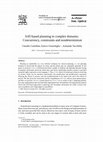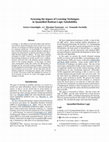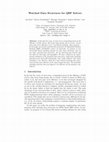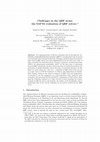Papers by Armando Tacchella
This paper reports about the 2004 comparative evaluation of solvers for quantified Boolean formul... more This paper reports about the 2004 comparative evaluation of solvers for quantified Boolean formulas (QBFs), the second in a series of non-competitive events established with the aim of assessing the advancements in the field of QBF reasoning and related research. We evaluated sixteen solvers on a test set of about one thousand benchmarks selected from instances submitted to the evaluation and from those available at www.qbflib.org. In the paper we present the evaluation infrastructure, from the criteria used to select the benchmarks to the hardware set up, and we show different views about the results obtained, highlighting the strength of different solvers and the relative hardness of the benchmarks included in the test set.

Artificial Intelligence, 2003
Planning as satisfiability is a very efficient technique for classical planning, i.e., for planni... more Planning as satisfiability is a very efficient technique for classical planning, i.e., for planning domains in which both the effects of actions and the initial state are completely specified. In this paper we present C-SAT, a SAT-based procedure capable of dealing with planning domains having incomplete information about the initial state, and whose underlying transition system is specified using the highly expressive action language C. Thus, C-SAT allows for planning in domains involving (i) actions which can be executed concurrently; (ii) (ramification and qualification) constraints affecting the effects of actions; and (iii) nondeterminism in the initial state and in the effects of actions. We first prove the correctness and the completeness of C-SAT, discuss some optimizations, and then we present C-PLAN, a system based on C-SAT. C-PLAN works on any C planning problem, but some optimizations have not been fully implemented yet. Nevertheless, the experimental analysis shows that SAT-based approaches to planning with incomplete information are viable, at least in the case of problems with a high degree of parallelism.
This paper is devoted to the experimental evaluation of several state-of-the-art search heuristic... more This paper is devoted to the experimental evaluation of several state-of-the-art search heuristics and optimization techniques in propositional satisFIability (SAT). The test set consists of random 3CNF formulas as well as real world instances from planning, scheduling, circuit analysis, bounded model checking, and security protocols. All the heuristics and techniques have been implemented in a new library for SAT, called SIM. The comparison is fair because in sim the selected heuristics and techniques are realized on a common platform. The comparison is significative because sim as a solver performs very well when compared to other state- of-the-art solvers.

Learning, i.e., the ability to record and exploit some information which is unveiled during the s... more Learning, i.e., the ability to record and exploit some information which is unveiled during the search, proved to be a very effective AI technique for problem solving and, in particular, for constraint satisfaction. In we have introduced learning as a general purpose technique to improve the performances of decision procedures for Quantified Boolean Formulas (QBFs). We have added learning techniques to QUBE, a state-of-the-art QBF solver. Embedding learning techniques in QUBE proved to be a challenging task, which also led to the definition and the implementation of new pruning strategies. In this paper, we report some experimental results that witness the effectiveness of learning and the associated pruning strategies. Noticeably, QUBE augmented with learning is able to solve instances that were previously out if its reach. On the other hand, the additional complexity of learning does impose some overhead on QUBE. We present results that highlight the presence of such overhead, we discuss its causes, and suggest possible remedies in QUBE.
Planning as satisfiability is an efficient technique for classical planning. In previous work by ... more Planning as satisfiability is an efficient technique for classical planning. In previous work by the second author, this approach has been extended to conformant planning, that is, to planning domains having incomplete information about the initial state and/or the effects of actions. In this paper we present some domain independent optimizations to the basic procedure described in the previous work. A comparative experimental analysis shows that the resulting procedure is competitive with other state-of-the-art conformant planners on domains with a high degree of parallelism.
Journal of Applied Non-classical Logics, 2000
This paper follows on previous papers which present and evaluate various decision procedures for ... more This paper follows on previous papers which present and evaluate various decision procedures for modal logics. It con rms previous experimental results in showing that SAT based decision procedures, i.e., the procedures built on top of decision procedures for propositional satis ability, are more e cient than tableau based decision procedures. It also con rms previous evidence of an easy-hard-easy pattern in the satis ability curve for modal K. Finally, it provides further experimental results, suggesting that SAT based decision procedures are also more e cient than the decision procedures based on translation methods. These results contradict some of the claims presented in previous papers by other authors.
Journal of Automated Reasoning, 2002
Symbolic model checking is a very successful formal verification technique, classically based on ... more Symbolic model checking is a very successful formal verification technique, classically based on Binary Decision Diagrams (BDDs). Recently, propositional satisfiability (SAT) techniques have been proposed as a computational basis for symbolic model checking, and proved to be an effective alternative to BDD-based techniques. In this paper we show how BDD-based and SAT-based techniques have been effectively integrated within the NuSMV symbolic model checker.

In the last few years, we have seen a tremendous boost in the efficiency of SAT solvers, this boo... more In the last few years, we have seen a tremendous boost in the efficiency of SAT solvers, this boost being mostly due to Chaff. Chaff owes some of its efficiency to its “two-literal watching” data structure. In this paper we present watched data structures for Quantified Boolean Formula (QBF) satisfiability solvers. In particular, we propose (i) two Chaff-like literal watching schemes for unit clause detection; and (ii) two other watched data structures, one for detecting pure literals and the other for detecting void quantifiers. We have conducted an experimental evaluation of the proposed data structures, using both randomly generated and real-world benchmarks. Our results indicate that clause watching is very effective, while the 2 and 3 literal watching data structures become more effective as the clause length increases. The quantifier watching structure does not appear to be effective on the instances considered.
Trivial truth and backjumping are two optimization techniques that have been proposed for decidin... more Trivial truth and backjumping are two optimization techniques that have been proposed for deciding quantified boolean formulas (QBFs) satisfiability. Both these techniques can greatly improve the overall performance of a QBF solver, but they are the expression of opposite philosophies. On one hand, trivial truth is a “look-ahead” policy: it is applied when descending the search tree to (try to) prune it. On the other hand, backjumping is a “look-back” policy: it is applied when backtracking to (try to) avoid useless explorations. Neither of these optimizations subsumes the other: it is easy to come up with examples in which trivial truth behaves much better than backjumping, and the other way around. In this paper we experimentally evaluate these two optimizations both on randomly generated and on real world test cases.
The best currently available solvers for Quantified Boolean Formulas (QBFs) process their input i... more The best currently available solvers for Quantified Boolean Formulas (QBFs) process their input in prenex form, i.e., all the quantifiers have to appear in the prefix of the formula separated from the purely propositional part representing the matrix. However, in many QBFs deriving from applications, the propositional part is intertwined with the quantifier structure. To tackle this problem, the standard approach is to convert such QBFs in prenex form, thereby loosing structural information about the prefix. In the case of search based solvers, the prenex form conversion introduces additional constraints on the branching heuristic, and reduces the benefits of the learning mechanisms.
Journal of Automated Reasoning, 2002

The usefulness of Bounded Model Checking (BMC) based on propositional satisfiability (SAT) method... more The usefulness of Bounded Model Checking (BMC) based on propositional satisfiability (SAT) methods for bug hunting has already been proven in several recent work. In this paper, we present two industrial strength systems performing BMC for both verification and falsification. The first is Thunder, which performs BMC on top of a new satisfiability solver, SIMO. The second is Forecast, which performs BMC on top of a BDD package. SIMO is based on the Davis Logemann Loveland procedure (DLL) and features the most recent search methods. It enjoys static and dynamic branching heuristics, advanced back-jumping and learning techniques. SIMO also includes new heuristics that are specially tuned for the BMC problem domain. With Thunder we have achieved impressive capacity and productivity for BMC. Real designs, taken from Intel’s Pentium©4, with over 1000 model variables were validated using the default tool settings and without manual tuning. In Forecast, we present several alternatives for adapting BDD-based model checking for BMC. We have conducted comparison of Thunder and Forecast on a large set of real and complex designs and on almost all of them Thunder has demonstrated clear win over Forecast in two important aspects: capacity and productivity.
In this paper we describe QuBE++, an efficient solver for Quantified Boolean Formulas (QBFs). To ... more In this paper we describe QuBE++, an efficient solver for Quantified Boolean Formulas (QBFs). To the extent of our knowledge, QuBE++ is the first QBF reasoning engine that uses lazy data structures both for unit clauses propagation and for pure literals detection. QuBE++ also features non-chronological backtracking and a branching heuristic that leverages the information gathered during the backtracking phase. Owing to such techniques and to a careful implementation, QuBE++ turns out to be an efficient and robust solver, whose performances exceed those of other state-of-the-art QBF engines, and are comparable with the best engines currently available on SAT instances.

The implementation of effective reasoning tools for deciding the satisfiability of Quantified Boo... more The implementation of effective reasoning tools for deciding the satisfiability of Quantified Boolean Formulas (QBFs) is an important issue in several research fields such as Formal Verification, Planning, and Reasoning about Knowledge. Several QBF solvers have been implemented in the last few years, most of them extending the well-known Davis, Putnam, Logemann, Loveland procedure (DPLL) for propositional satisfiability (SAT). At the same time, a substantial breed of QBF benchmarks emerged, both in the form of statistical models for the generation of random formulas, and in the form of real-world instances. In this paper we report about the – first ever – evaluation of QBF solvers that was run as a joint event to SAT’03 Conference on Theory and Applications of Satisfiability Testing. Owing to the relative youngness of QBF tools and applications, we decided to run the comparison on a non-competitive basis, using the same technology that powered SAT’02 and SAT’03 competitions of SAT solvers. Running the evaluation enabled us to collect all sorts of data regarding the relative strength of different solvers and methods, the quality of the benchmarks, and to understand some of the current challenges for researchers involved in the QBF arena.











Uploads
Papers by Armando Tacchella